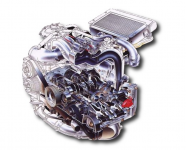Lord flashhearts mega info thread. i will continue working on this, adding pics, editing. my goal is to have this powerful refrence tool for my fellow subaru guys. i know its gonna take a while. i have some pics to go with it, but i need to go to work and take more pics (not happening since i just got my wisdom teeth out today.) stay tuned.
Here we go. I am starting this on 1/18/2012, and I am going to compile all the information I possibly can. It will be targeted towards engine building because thats what I know best and do for a living.
This is my attemt to get information out to the SL-i community so that they dont sound ignorant when they talk. This Is going to be very difficult, and I would like to verify all the information prior to posting it. However we all make mistakes, if you notice a mistake pleas notify me and I will change it.
There will be a glossary at the end.
Ok so im going to try to format this the very best I can..
part 1..................................................EJ-series 101
part 2....................................................Shortblocks
part 3.............................................................Heads
part 4..........................Engine building information
-Sub categorys
Torgue specifications.
General information
compression ratio tips
franken-motor info
volumetric information
part 5.....................................OEM Turbochargers
part 6.....................................Engine management
-Sub categorys
OEM
Aftermarket
part 7...............................................Transmissions
part 8..............................Maintenance information
part 9.................................................Helpful links
part 10...................................................... glossary
Please PM info to me.
Part 1
EJ engines 101
Ok, lets start off with an introduction to the EJ. There is a lot of information in this section so we are going to skip over some of the less important stuff like the EJ15,EJ16 and I will only lightly touch on the single cam (SOHC) EJ25s
so much of this I will copy, paste, and add my own info.
So here is an excript of wikipidia page for the Subaru EJ engines.
This is mostly for refrence so you can follow the rest of this thread.
If your looking for Head volume see the “heads” section
EJ20T
This is not actually a valid code from Subaru, but is mostly used by enthusiasts and also mechanics to describe the entire line of 2.0 litre turbocharged engines that have been available over time. The practice began with the incorrect designation of the USA-spec turbo, commonly referred to as the EJ22T, and the habit of referring to any turbocharged engine as a "T" began. When referring to the EJ20T, one is speaking of one of the following:
EJ20G
EJ20G engines fall in to 3 categories:
1. Rocker-style HLA EJ20G usage:
Legacy RS 89-93
Legacy RS-RA 89-93
Legacy GT 89-93
Power output ranges from 200 PS (147 kW; 197*bhp) @ 6000*rpm and 260 Nm for the GT to 220 PS (162 kW; 217*bhp) @ 6400*rpm and 270 Nm for the RS versions. Engines can be identified by coil on plug with 2 M6 bolts per coil and valve covers with 4CAM 16VALVE and horizontal lines above and below the plug holes. All these engines have the air-to-water intercooler setup (chargecooler) and Oil squirters.
2. Bucket-style HLA EJ20G usage:
Impreza WRX 92~96
Impreza WRX Wagon 92~96
Impreza WRX STI 93~96
EUDM Subaru Impreza Turbo 94~96
Power output ranges from 220 PS @ 6000*rpm and 260 Nm for the WRX Wagons to 275 PS @ 6500*rpm and 319 Nm for the WRX STI Version II. Engines can be identified by coil on plug with 1 M8 bolt per coil and valve covers with 4CAM 16VALVE and horizontal lines above the plug holes. Generally these engines all have the slanted intercooler. Some engines may not have HLA buckets but solid buckets with shims underneath. These engines also feature lighter valves, the intake valves are marked INKO and the exhaust valves are marked EXKO. The standard HLA valves are I252 and E283 respectively. All WRX Wagon engines and automatic sedan engines came with a TD04 with 90 deg elbow, all manual WRX sedans including STI versions all had a TD05 with 90 deg elbow.
3. Shim-over-bucket style EJ20G usage:
Impreza WRX AT 97~98
Impreza WRX AT Wagon 97~98
JDM Forester Turbo 97~98
EUDM Subaru Impreza Turbo 97~98
Power output is 250 PS @ 6000*rpm for the Japanese versions and 211 PS for the European model. Engines can be identified by smoothvalve covers, plug leads and a wasted spark coil in the middle of the intake manifold. These engines were available with both manual and automatic transmission in Japan, but generally had manual the transmission in Europe in the Impreza Turbo.
EJ20K
to identify an EJ20K
Wasted spark coil pack on center of manifold
Inlet under manifold
Divorced idle air controller
Usage:
Impreza WRX & STi 9/96~9/98
EJ205
This engine series is used for non-Japanese marketed WRX models in the world market as of 1999. The Japanese WRX models use theEJ207 from 1999~2001, except the 5-door wagon which also uses the EJ205. After 2001, all WRXs use the EJ205, with an exception of the USDM models, which used the EJ205 until 2005. The EJ205 has a 8:1 compression ratio.
To identify an EJ205:
Coil on plug*
idle air integrated into throttle body
open deck block
Usage: Impreza WRX
99~01 (JDM Wagon Body only)
01~current (all JDM)including Forester Cross Sports and STI (9:1 compression ratio)
02~05 (USDM)
99~current (all other markets)
NOTE: The Australian Spec MY00 EJ205 does not have coil on plug but can be identified from the VIN of the vehicle (if known) where the 10th digit will be Y (for year 2000) and the 6th Digit will be 8 (for the 2000yr/EJ205)
EJ207
The EJ207 has a 8.0:1 compression ratio.
To identify an 9/99-9/2000 EJ207
Wasted spark coil pack off center of manifold
Inlet under manifold
Red intake manifold
Semi-closed deck block
Usage:
Impreza WRX STi 1998~present (JDM, specifically Homologation models for World Rally Championship)
EJ20TT
This can refer to one of the 2.0 Litre DOHC Sequential Twin Turbo and intercooled engines (EJ20H/EJ20R/EJ206/EJ208), yet like EJ20T, it is not actually a valid code used by Subaru themselves. Used from 1994 to 2005 in various iterations listed below. Due to the tight confines of the engine bay, the twin turbo engine was installed in Japanese-spec Legacies only, which were right-hand drive. The twin turbo setup will not fit in US-spec Subarus due to the brake and steering setup of a left-hand drive car. A detuned version was sold in Australia.[1] Twin turbo vehicles can be found as grey market imports to countries that utilize right hand drive. Twin turbo engines can be bought on auction sites and import sites as well.
EJ20H
Usage:
1993-1998 Legacy chassis code BD/BG5 JDM RS, RS-B and GT's ( 183*kW (249*PS; 245*bhp) manual & automatic) and auto RS-B and GT-B's (206*kW (280*PS; 276*bhp) automatic)
EJ20R
Usage:
1996-1998 Legacy chassis code BD/BG5 JDM manual RS-B and GT-B's (206*kW (280*PS; 276*bhp) Manual)
EJ206
Usage:
1998-2003 Legacy chassis code BE/BH5 JDM GT's, GT-B's and B4's (190*kW (258*PS; 255*bhp) Auto)
EJ208
Usage:
1998-2003 Legacy chassis code BE/BH5 JDM GT's, GT-B's and B4's (206*kW (280*PS; 276*bhp) Manual)
EJ22
Usage:
Impreza 95-01
Legacy 90-99, Outback 95-99
Specifications
Displacement: 2212 cc
Bore: 96.9*mm
Stroke: 75.0*mm
Compression Ratio: 9.5:1 - 9.7:1
Valvetrain: SOHC
Fuel Delivery multi-point fuel injection
EJ221 Naturally Aspirated
Horsepower: 135*bhp (101*kW; 135*bhp) @ 5800*rpm
Torque: 186.3*N·m (137*lb·ft) @ 4800*rpm
EJ222 Naturally Aspirated
Horsepower: 142*bhp (106*kW; 144*PS) @ 5600*rpm
Torque: 149*lb·ft (202*N·m) @ 3600*rpm
EJ22E
2.2 litre
135*bhp (101*kW) @ 5800*rpm 140*ft·lbf (190*N·m) @ 4800*rpm Australian model - 100*kW (130*hp) @ 6000*rpm 189*N·m (139*ft·lbf) @ 4800*rpm Usage:
Legacy 90-96
Impreza 93-97
EJ22T
Phase one 2.2 Liter SOHC Turbo, 163*bhp (122*kW; 165*PS) fully closed deck, oil squirters, no intercooler
Legacy 1991-1994 (North American-spec)
EJ22G
Phase two 2.2 litre closed deck
Displacement: 2212 cc
Bore: 96.9*mm
Stroke: 75.0*mm
Compression Ratio: 8.0:1
Valvetrain: DOHC
Fuel Delivery multi point fuel injection
EJ22G Turbo DOHC
Horsepower: 280*PS (206*kW; 276*bhp) @ 6000*rpm
Torque: 362.8*N·m (268*lb·ft) @ 3200*rpm
Usage:
Impreza STi 22B GC8 series(JDM)
Legacy STi BF7 and BFB series wagon (JDM)
EJ25
Displacement: 2457 cc
Bore: 99.5*mm
Stroke: 79.0*mm
Compression Ratio: 9.5:1 - 10.0:1 Naturally Aspirated
Compression Ratio: 8.0:1 - 9.5:1 Turbo
Fuel Delivery multi point fuel injection
EJ25D
The EJ25D has demonstrated leaking head gasket issues on occasion. This was due to a design flaw of the OEM gaskets. Since the release of the EJ25D, an updated gasket is available that is not prone to failure. There were two variations of the EJ25D sold in the US market. The engine was introduced in 1996 in the Legacy 2.5GT, LSi, and Legacy Outback. That version of the engine used HLA heads, was recommended to be run on 91 octane fuel, had lower power and torque ratings than the later '97-99 EJ25D, and was only offered with an automatic transmission. In 1997 a revised engine was introduced that used heads with shimmed bucket lifters (versus the HLAs), was designed to run on 87 octane fuel, and was available with either a manual or automatic transmission.
DOHC (1996) - SAE - 155*hp (116*kW) @ 5600*rpm
140*ft·lbf (190*N·m) at 2800*rpm
DOHC (1997–1999) - SAE - 165*hp (123*kW) @ 5600*rpm
162*ft·lbf (220*N·m) at 4000*rpm
Usage
Impreza 98
Legacy/Outback 96~99
Forester 98
EJ251
The EJ251 has demonstrated externally leaking head gasket issues on occasion as the engine accumulates mileage over 100,000 miles (160,934.4 km). SOHC Intake volume is calculated by the use of a MAP sensor, unlike the EJ253 which uses a MAF sensor. Compression ratio is 10.0: 1.
Power ISO: 123*kW (165*hp) @ 5600*RPM
226*N·m (167*ft·lbf) @ 4000*rpm
Usage:
Impreza 2.5RS, 2.5TS 00-04 (US)
Impreza Outback Sport 02-04 (US)
Forester 00-04 (US)
Legacy 00-04 (US)
Outback 00-04 (US)
Baja 03-05 (US)
EJ252
SOHC Power ISO 115*kW (156*hp) Usage:
Legacy/Outback 00
Forester 00
EJ253
SOHC - ISO 173*hp (129*kW) @ 5600*rpm, 166*ft·lbf (225*N·m) torque @ 4000*rpm. Intake volume is regulated by use of a MAFsensor, unlike the EJ251 which is regulated by a MAP sensor. I-Active valves (VVL intake side) on 06+ models.
Impreza 99, 05+
Legacy, Outback USA 05+
Forester 99, 05+
Baja 05+
Saab 9-2x Linear 05, 06
EJ254
SOHC 16-valve Power SAE 121*kW (165*hp), 2005–present - 175*hp (130*kW).
Usage:
Impreza RS 02~04
Forester 04
Legacy/Outback 02~04, 05-present
Legacy Lancaster RHD 1999-2003
EJ255
DOHC turbocharged, with sodium-filled valves originally designed for North American market, now sees usage in some European Imprezas and Legacies destined for Australia and South Africa. Power 210-265*hp
Usage in North America:
Impreza: 2006–present
Forester: 2004–present
Legacy: 2005–present
Outback: 2005-2009
Baja: 2004 - 2006
Usage in the rest of the world:
Legacy/Outback: 2007–present
Impreza: 2006–present
Forester: 2005–2010
EJ257
DOHC 16-valve turbo. Originally designed for the North American Impreza STI in 2004 with AVCS and DBW. The same exact shortblock as EJ255 except the EJ255 has a different domed piston vs the EJ257. The heads also have different components. Subaru of America designates the same part numbers for an EJ255 shortblock, and EJ257 shortblock with the exception of the pistons.
Usage:
US Market Impreza WRX STi MY04~MY07 (300*hp, 293*hp (New SAE standard))
US Market Impreza WRX STI MY08~MY10 (305*hp (New SAE standard))
US Market Subaru Legacy/Subaru Outback MY05~MY06
Asian, European Market Impreza WRX STi 05~present (280*hp, 40KGh/m)
JDM Forester STI MY05~present
Part 2
Shortblocks.


I mostly wanted to point out the differences in the phase 1 and phase 2. as the more technical information, and specs will be covered in the engine building section.
the nice thing about subarus is that they can be treated like legos.
All you have to do is make sure that the parts you want to use are compatable.
Now there are two Generations of Ejs. A couple differences.
The first generation: (pre 1999)
the thrust bearing is in the #3 position.
Bellhousing uses 4 bolts
smaller rod bore
second generation: (post 1999)
thrust bearing is in the rear #5 position
bellhousing uses 8 bolts
larger rod bore.
They also changed the ignition triggers.
The phase 1 EJ18,EJ20,EJ22 use the same crank. And the EJ25D used a smaller rod bore, which
resulted in the occasional broken crank. Due to the lack of journal overlap.
The phase 2 EJ222, and the EJ205 use the same rods, crank. The EJ222 also has 2 sets of valves reliefs, one set lines up with the DOHC Turbo heads. (see picture below)
Since the major revision in 1999 few, changes were made internaly to the shortblocks. And the changes that were made were minimal. Altho in 1996 subaru did do a slight refinement. Most changes were in the Cylinder head, (explained in the heads section) but the shortblocks did see changes in the piston. The EJ25 got a different piston, with slightly more dish.(accomidating the new head.) the EJ22 also got some internal tweeking. They changed the piston, particularly the coating on the skirt. To reduce mechanical drag.
this is the EJ222 piston.

Part 3
Heads



it seems like the most frequent and major changes over the years were to cylider heads.
now there are 3 intake manifold paterns the the small port EJ22, the phase 1 EJ25, and the phase 2 EJ pattern.
this is the pre-1999 SOHC style manifold.

then there is the pre-1999 DOHC style.

and finally the Post 1999 SOHC and DOHC.
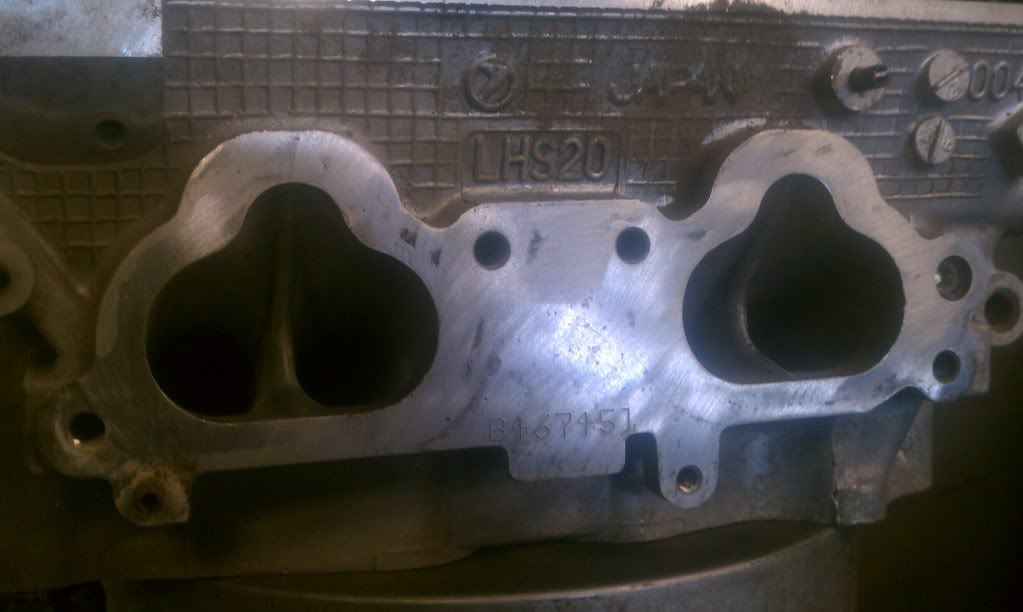
EJ22E/EJ221: 1991-1998
SOHC
Hydraulic (EJ221 mechanical)
dual port exhaust (EJ221 single port)
poor flowing
head volume: 40cc
Peak valve lift is just over .300 with the factory camshaft.
the valve sizes in this engine are quite small at 31 and 28 mm for a 2.2 liter engine, no larger than many 1.6 liter engines
EJ22T: 1991-1994
pretty much the same heads as the EJ22E, but has plumbing for the Turbocharger. Besides that, I havent seen any evidence that the N/A EJ22E and the EJ22T heads are any different.
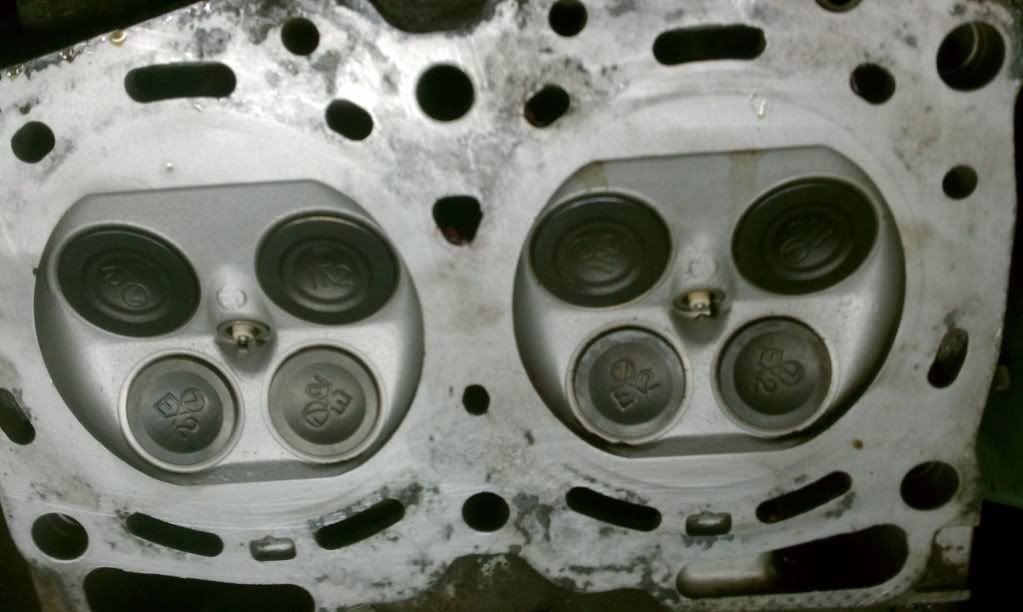
EJ222: 1999-2001
Phase 2.
Large valve cover , with greatly improved port design. And flow numbers
mechanical rocker-style lash ajusters
unfortunatly I dont have any solid information on the head volume, cam duration, lift right now.
So please let me know. Other wise I will do what I can.
EJ25D (1996)
this was the first year of the EJ25D. And as far as heads go they are very closely related to the
EJ20G hydraulic bucket-style heads. They used the same casting. Had a 'pent roof' combustion
chamber. Oddly enough they are less prone to blowing head gaskets as the later EJ25D.
Head volume 54cc

EJ25D (1997-1999)
like the hydralic EJ25D, the mechanical also has a 2.0 turbochared cousin. That would be the EJ20K.
Rather than using the pent-roof combustion chamber it uses a 'clover' shaped combustion chamber.
And is a shim-over-bucket, which reduces the internal friction of the engine, however these heads have been noted to have issues with head gaskets.
It has also been proven that de-shrouding the valves makes these heads flow very well.
46cc head volume
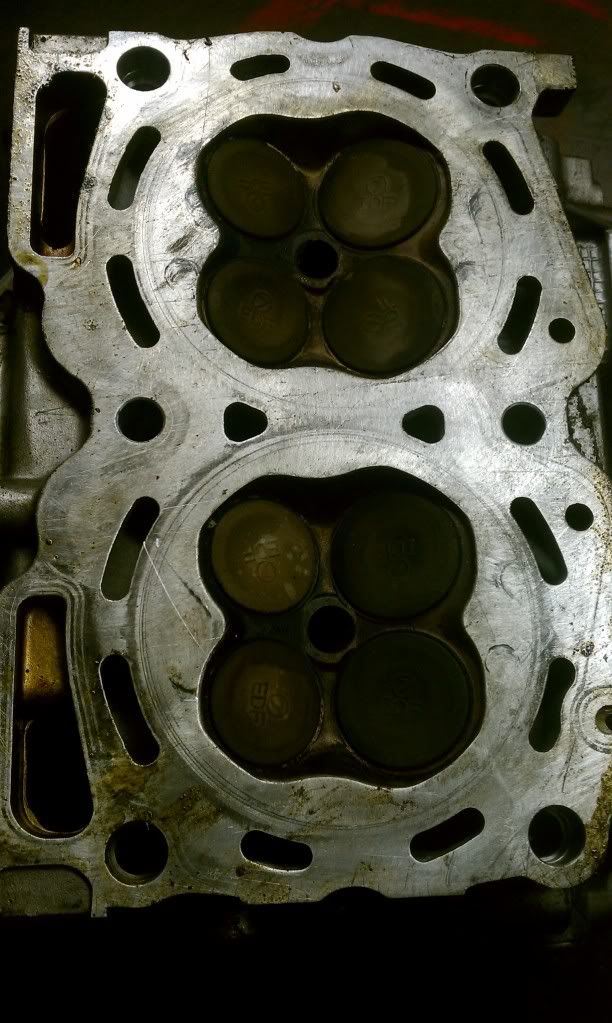
EJ20G, 1991-1997 (JDM)
there were 3 phases to these heads.
Hydraulic rocker-style unknown head volume
Hydraulic bucket-style head volume 54cc
Shim-over-bucket head volume 46.6cc (unconfirmed)
used on WRXs, Stis, and Legacys in japan, these were never used in the US.
altho the early rocker-style heads flowed better than the EJ22T heads, they still were not the best design. Also it is becoming increasingly difficult to get replacement lifters in the USA.
EJ20K 1998
closely related to the EJ25D, these were the first 'real' performace head
subaru produced.
It was a shim-under-bucket, sodium-filled valves, stiff springs, allowed for high RPM
and good flow in the Top end. Uses the clover style combustion chamber
46cc
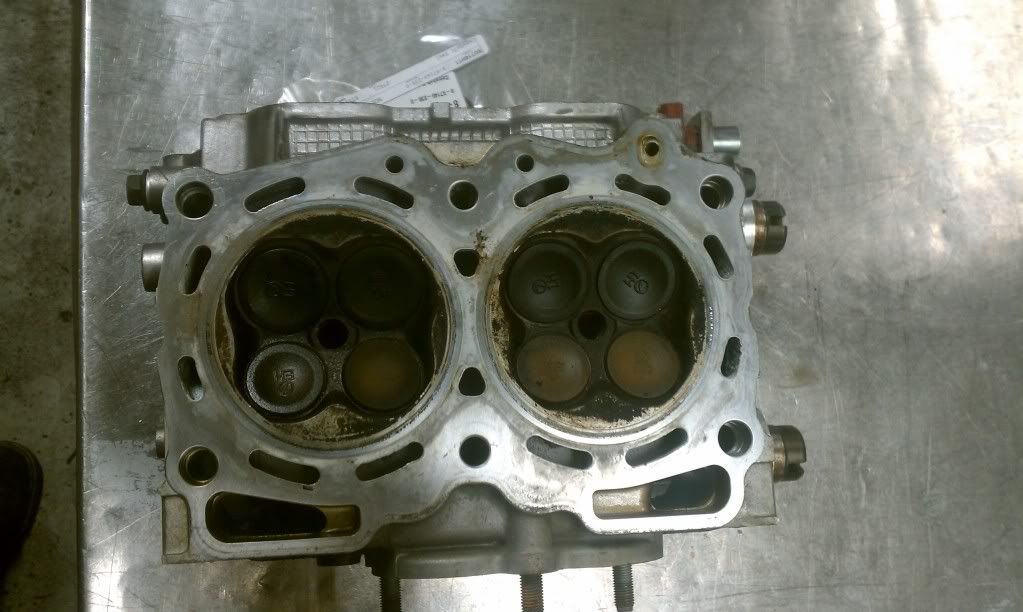
EJ205 WRX 2000-current (jdm)
first head with the revised ports, and new intake manifold pattern.
Reverted to the pent-roof design.
Shimless bucket-style
head volume 51cc
this is the combustion chamber of a de-shrouded EJ205
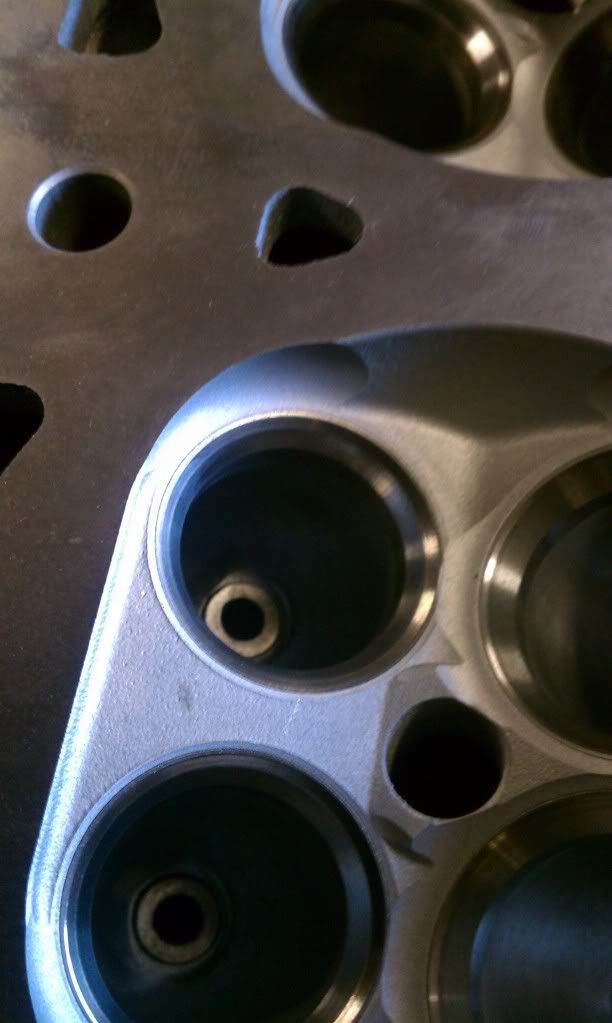
EJ207 JDM Sti
cousin to the EJ205
head volume 50cc
also uses new manifold bolt pattern
sodium-filled valves
shimless bucket-style
EJ257 USDM STI
head volume 57ccs
shimless bucket-style
sodium-filled valves
AVCS
B25
EJ255 USDM WRX
head volume 51cc
shimless bucket-style
sodium-filled valves
AVCS
D25
EJ251
SOHC
better flow than the DOHC EJ25D
rocker-style lash ajusters.
Pentroof combustion chamber
combustion chamber 50cc
EJ253
sohc
basically the same head as the EJ251 but with AVCS
50cc head volume.
WHAT DOES A SUBARU HEAD LOOK LIKE INSIDE?


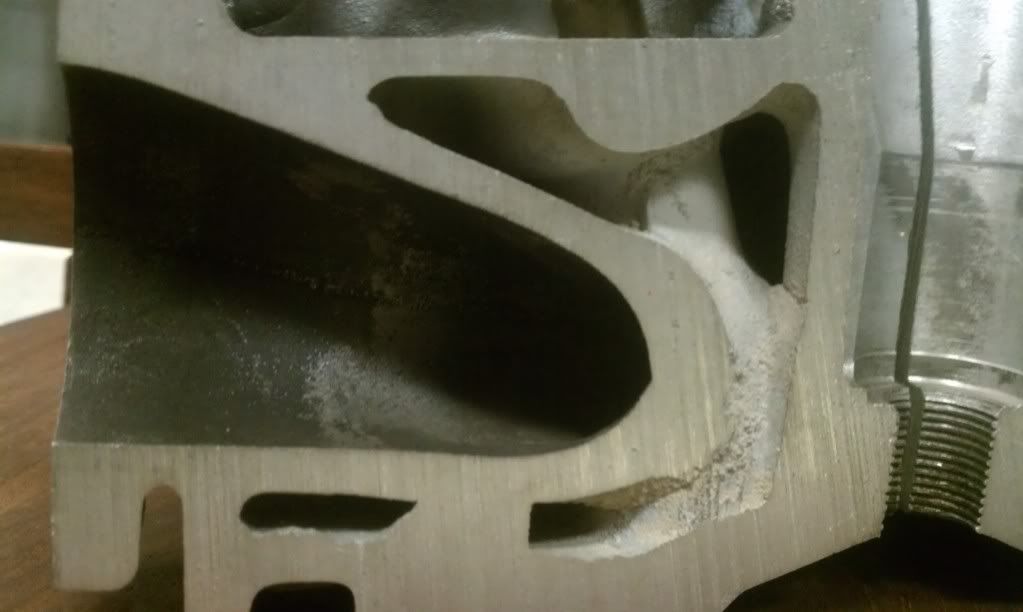
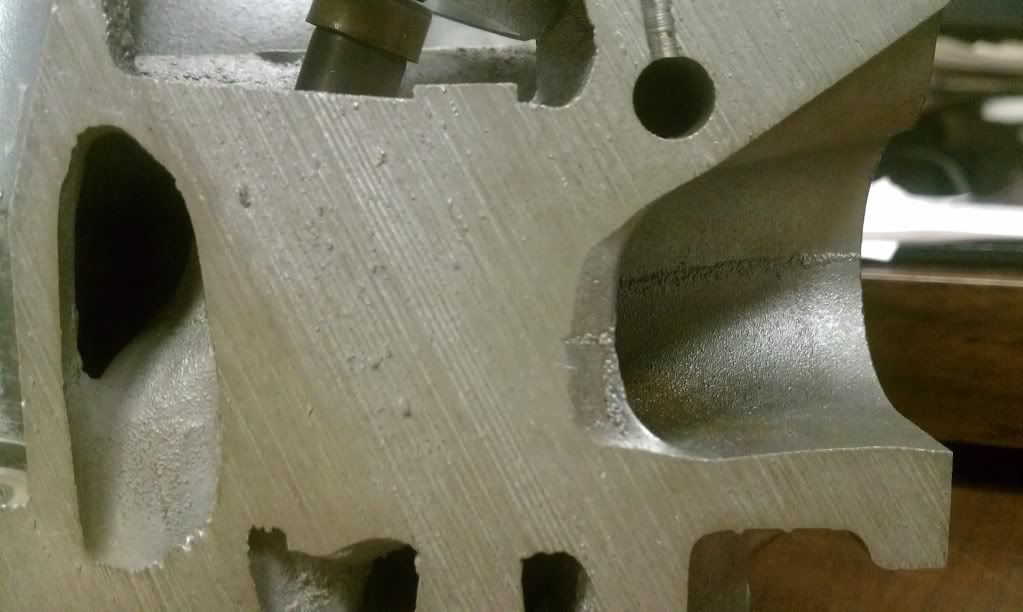
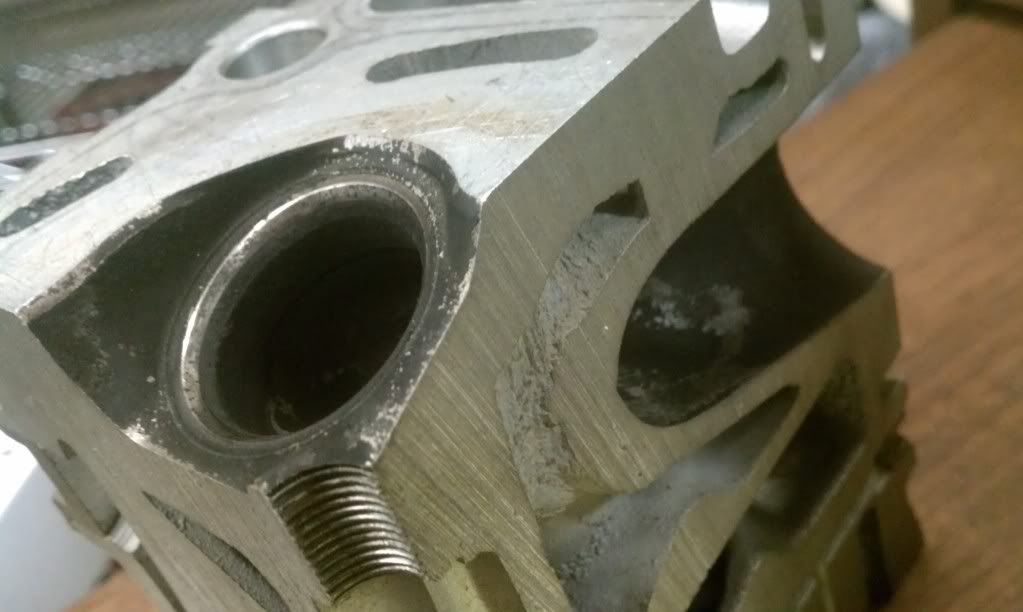

done with heads.
Here we go. I am starting this on 1/18/2012, and I am going to compile all the information I possibly can. It will be targeted towards engine building because thats what I know best and do for a living.
This is my attemt to get information out to the SL-i community so that they dont sound ignorant when they talk. This Is going to be very difficult, and I would like to verify all the information prior to posting it. However we all make mistakes, if you notice a mistake pleas notify me and I will change it.
There will be a glossary at the end.
Ok so im going to try to format this the very best I can..
part 1..................................................EJ-series 101
part 2....................................................Shortblocks
part 3.............................................................Heads
part 4..........................Engine building information
-Sub categorys
Torgue specifications.
General information
compression ratio tips
franken-motor info
volumetric information
part 5.....................................OEM Turbochargers
part 6.....................................Engine management
-Sub categorys
OEM
Aftermarket
part 7...............................................Transmissions
part 8..............................Maintenance information
part 9.................................................Helpful links
part 10...................................................... glossary
Please PM info to me.
Part 1
EJ engines 101
Ok, lets start off with an introduction to the EJ. There is a lot of information in this section so we are going to skip over some of the less important stuff like the EJ15,EJ16 and I will only lightly touch on the single cam (SOHC) EJ25s
so much of this I will copy, paste, and add my own info.
So here is an excript of wikipidia page for the Subaru EJ engines.
This is mostly for refrence so you can follow the rest of this thread.
If your looking for Head volume see the “heads” section
EJ20T
This is not actually a valid code from Subaru, but is mostly used by enthusiasts and also mechanics to describe the entire line of 2.0 litre turbocharged engines that have been available over time. The practice began with the incorrect designation of the USA-spec turbo, commonly referred to as the EJ22T, and the habit of referring to any turbocharged engine as a "T" began. When referring to the EJ20T, one is speaking of one of the following:
EJ20G
EJ20G engines fall in to 3 categories:
1. Rocker-style HLA EJ20G usage:
Legacy RS 89-93
Legacy RS-RA 89-93
Legacy GT 89-93
Power output ranges from 200 PS (147 kW; 197*bhp) @ 6000*rpm and 260 Nm for the GT to 220 PS (162 kW; 217*bhp) @ 6400*rpm and 270 Nm for the RS versions. Engines can be identified by coil on plug with 2 M6 bolts per coil and valve covers with 4CAM 16VALVE and horizontal lines above and below the plug holes. All these engines have the air-to-water intercooler setup (chargecooler) and Oil squirters.
2. Bucket-style HLA EJ20G usage:
Impreza WRX 92~96
Impreza WRX Wagon 92~96
Impreza WRX STI 93~96
EUDM Subaru Impreza Turbo 94~96
Power output ranges from 220 PS @ 6000*rpm and 260 Nm for the WRX Wagons to 275 PS @ 6500*rpm and 319 Nm for the WRX STI Version II. Engines can be identified by coil on plug with 1 M8 bolt per coil and valve covers with 4CAM 16VALVE and horizontal lines above the plug holes. Generally these engines all have the slanted intercooler. Some engines may not have HLA buckets but solid buckets with shims underneath. These engines also feature lighter valves, the intake valves are marked INKO and the exhaust valves are marked EXKO. The standard HLA valves are I252 and E283 respectively. All WRX Wagon engines and automatic sedan engines came with a TD04 with 90 deg elbow, all manual WRX sedans including STI versions all had a TD05 with 90 deg elbow.
3. Shim-over-bucket style EJ20G usage:
Impreza WRX AT 97~98
Impreza WRX AT Wagon 97~98
JDM Forester Turbo 97~98
EUDM Subaru Impreza Turbo 97~98
Power output is 250 PS @ 6000*rpm for the Japanese versions and 211 PS for the European model. Engines can be identified by smoothvalve covers, plug leads and a wasted spark coil in the middle of the intake manifold. These engines were available with both manual and automatic transmission in Japan, but generally had manual the transmission in Europe in the Impreza Turbo.
EJ20K
to identify an EJ20K
Wasted spark coil pack on center of manifold
Inlet under manifold
Divorced idle air controller
Usage:
Impreza WRX & STi 9/96~9/98
EJ205
This engine series is used for non-Japanese marketed WRX models in the world market as of 1999. The Japanese WRX models use theEJ207 from 1999~2001, except the 5-door wagon which also uses the EJ205. After 2001, all WRXs use the EJ205, with an exception of the USDM models, which used the EJ205 until 2005. The EJ205 has a 8:1 compression ratio.
To identify an EJ205:
Coil on plug*
idle air integrated into throttle body
open deck block
Usage: Impreza WRX
99~01 (JDM Wagon Body only)
01~current (all JDM)including Forester Cross Sports and STI (9:1 compression ratio)
02~05 (USDM)
99~current (all other markets)
NOTE: The Australian Spec MY00 EJ205 does not have coil on plug but can be identified from the VIN of the vehicle (if known) where the 10th digit will be Y (for year 2000) and the 6th Digit will be 8 (for the 2000yr/EJ205)
EJ207
The EJ207 has a 8.0:1 compression ratio.
To identify an 9/99-9/2000 EJ207
Wasted spark coil pack off center of manifold
Inlet under manifold
Red intake manifold
Semi-closed deck block
Usage:
Impreza WRX STi 1998~present (JDM, specifically Homologation models for World Rally Championship)
EJ20TT
This can refer to one of the 2.0 Litre DOHC Sequential Twin Turbo and intercooled engines (EJ20H/EJ20R/EJ206/EJ208), yet like EJ20T, it is not actually a valid code used by Subaru themselves. Used from 1994 to 2005 in various iterations listed below. Due to the tight confines of the engine bay, the twin turbo engine was installed in Japanese-spec Legacies only, which were right-hand drive. The twin turbo setup will not fit in US-spec Subarus due to the brake and steering setup of a left-hand drive car. A detuned version was sold in Australia.[1] Twin turbo vehicles can be found as grey market imports to countries that utilize right hand drive. Twin turbo engines can be bought on auction sites and import sites as well.
EJ20H
Usage:
1993-1998 Legacy chassis code BD/BG5 JDM RS, RS-B and GT's ( 183*kW (249*PS; 245*bhp) manual & automatic) and auto RS-B and GT-B's (206*kW (280*PS; 276*bhp) automatic)
EJ20R
Usage:
1996-1998 Legacy chassis code BD/BG5 JDM manual RS-B and GT-B's (206*kW (280*PS; 276*bhp) Manual)
EJ206
Usage:
1998-2003 Legacy chassis code BE/BH5 JDM GT's, GT-B's and B4's (190*kW (258*PS; 255*bhp) Auto)
EJ208
Usage:
1998-2003 Legacy chassis code BE/BH5 JDM GT's, GT-B's and B4's (206*kW (280*PS; 276*bhp) Manual)
EJ22
Usage:
Impreza 95-01
Legacy 90-99, Outback 95-99
Specifications
Displacement: 2212 cc
Bore: 96.9*mm
Stroke: 75.0*mm
Compression Ratio: 9.5:1 - 9.7:1
Valvetrain: SOHC
Fuel Delivery multi-point fuel injection
EJ221 Naturally Aspirated
Horsepower: 135*bhp (101*kW; 135*bhp) @ 5800*rpm
Torque: 186.3*N·m (137*lb·ft) @ 4800*rpm
EJ222 Naturally Aspirated
Horsepower: 142*bhp (106*kW; 144*PS) @ 5600*rpm
Torque: 149*lb·ft (202*N·m) @ 3600*rpm
EJ22E
2.2 litre
135*bhp (101*kW) @ 5800*rpm 140*ft·lbf (190*N·m) @ 4800*rpm Australian model - 100*kW (130*hp) @ 6000*rpm 189*N·m (139*ft·lbf) @ 4800*rpm Usage:
Legacy 90-96
Impreza 93-97
EJ22T
Phase one 2.2 Liter SOHC Turbo, 163*bhp (122*kW; 165*PS) fully closed deck, oil squirters, no intercooler
Legacy 1991-1994 (North American-spec)
EJ22G
Phase two 2.2 litre closed deck
Displacement: 2212 cc
Bore: 96.9*mm
Stroke: 75.0*mm
Compression Ratio: 8.0:1
Valvetrain: DOHC
Fuel Delivery multi point fuel injection
EJ22G Turbo DOHC
Horsepower: 280*PS (206*kW; 276*bhp) @ 6000*rpm
Torque: 362.8*N·m (268*lb·ft) @ 3200*rpm
Usage:
Impreza STi 22B GC8 series(JDM)
Legacy STi BF7 and BFB series wagon (JDM)
EJ25
Displacement: 2457 cc
Bore: 99.5*mm
Stroke: 79.0*mm
Compression Ratio: 9.5:1 - 10.0:1 Naturally Aspirated
Compression Ratio: 8.0:1 - 9.5:1 Turbo
Fuel Delivery multi point fuel injection
EJ25D
The EJ25D has demonstrated leaking head gasket issues on occasion. This was due to a design flaw of the OEM gaskets. Since the release of the EJ25D, an updated gasket is available that is not prone to failure. There were two variations of the EJ25D sold in the US market. The engine was introduced in 1996 in the Legacy 2.5GT, LSi, and Legacy Outback. That version of the engine used HLA heads, was recommended to be run on 91 octane fuel, had lower power and torque ratings than the later '97-99 EJ25D, and was only offered with an automatic transmission. In 1997 a revised engine was introduced that used heads with shimmed bucket lifters (versus the HLAs), was designed to run on 87 octane fuel, and was available with either a manual or automatic transmission.
DOHC (1996) - SAE - 155*hp (116*kW) @ 5600*rpm
140*ft·lbf (190*N·m) at 2800*rpm
DOHC (1997–1999) - SAE - 165*hp (123*kW) @ 5600*rpm
162*ft·lbf (220*N·m) at 4000*rpm
Usage
Impreza 98
Legacy/Outback 96~99
Forester 98
EJ251
The EJ251 has demonstrated externally leaking head gasket issues on occasion as the engine accumulates mileage over 100,000 miles (160,934.4 km). SOHC Intake volume is calculated by the use of a MAP sensor, unlike the EJ253 which uses a MAF sensor. Compression ratio is 10.0: 1.
Power ISO: 123*kW (165*hp) @ 5600*RPM
226*N·m (167*ft·lbf) @ 4000*rpm
Usage:
Impreza 2.5RS, 2.5TS 00-04 (US)
Impreza Outback Sport 02-04 (US)
Forester 00-04 (US)
Legacy 00-04 (US)
Outback 00-04 (US)
Baja 03-05 (US)
EJ252
SOHC Power ISO 115*kW (156*hp) Usage:
Legacy/Outback 00
Forester 00
EJ253
SOHC - ISO 173*hp (129*kW) @ 5600*rpm, 166*ft·lbf (225*N·m) torque @ 4000*rpm. Intake volume is regulated by use of a MAFsensor, unlike the EJ251 which is regulated by a MAP sensor. I-Active valves (VVL intake side) on 06+ models.
Impreza 99, 05+
Legacy, Outback USA 05+
Forester 99, 05+
Baja 05+
Saab 9-2x Linear 05, 06
EJ254
SOHC 16-valve Power SAE 121*kW (165*hp), 2005–present - 175*hp (130*kW).
Usage:
Impreza RS 02~04
Forester 04
Legacy/Outback 02~04, 05-present
Legacy Lancaster RHD 1999-2003
EJ255
DOHC turbocharged, with sodium-filled valves originally designed for North American market, now sees usage in some European Imprezas and Legacies destined for Australia and South Africa. Power 210-265*hp
Usage in North America:
Impreza: 2006–present
Forester: 2004–present
Legacy: 2005–present
Outback: 2005-2009
Baja: 2004 - 2006
Usage in the rest of the world:
Legacy/Outback: 2007–present
Impreza: 2006–present
Forester: 2005–2010
EJ257
DOHC 16-valve turbo. Originally designed for the North American Impreza STI in 2004 with AVCS and DBW. The same exact shortblock as EJ255 except the EJ255 has a different domed piston vs the EJ257. The heads also have different components. Subaru of America designates the same part numbers for an EJ255 shortblock, and EJ257 shortblock with the exception of the pistons.
Usage:
US Market Impreza WRX STi MY04~MY07 (300*hp, 293*hp (New SAE standard))
US Market Impreza WRX STI MY08~MY10 (305*hp (New SAE standard))
US Market Subaru Legacy/Subaru Outback MY05~MY06
Asian, European Market Impreza WRX STi 05~present (280*hp, 40KGh/m)
JDM Forester STI MY05~present
Part 2
Shortblocks.


I mostly wanted to point out the differences in the phase 1 and phase 2. as the more technical information, and specs will be covered in the engine building section.
the nice thing about subarus is that they can be treated like legos.
All you have to do is make sure that the parts you want to use are compatable.
Now there are two Generations of Ejs. A couple differences.
The first generation: (pre 1999)
the thrust bearing is in the #3 position.
Bellhousing uses 4 bolts
smaller rod bore
second generation: (post 1999)
thrust bearing is in the rear #5 position
bellhousing uses 8 bolts
larger rod bore.
They also changed the ignition triggers.
The phase 1 EJ18,EJ20,EJ22 use the same crank. And the EJ25D used a smaller rod bore, which
resulted in the occasional broken crank. Due to the lack of journal overlap.
The phase 2 EJ222, and the EJ205 use the same rods, crank. The EJ222 also has 2 sets of valves reliefs, one set lines up with the DOHC Turbo heads. (see picture below)
Since the major revision in 1999 few, changes were made internaly to the shortblocks. And the changes that were made were minimal. Altho in 1996 subaru did do a slight refinement. Most changes were in the Cylinder head, (explained in the heads section) but the shortblocks did see changes in the piston. The EJ25 got a different piston, with slightly more dish.(accomidating the new head.) the EJ22 also got some internal tweeking. They changed the piston, particularly the coating on the skirt. To reduce mechanical drag.
this is the EJ222 piston.

Part 3
Heads



it seems like the most frequent and major changes over the years were to cylider heads.
now there are 3 intake manifold paterns the the small port EJ22, the phase 1 EJ25, and the phase 2 EJ pattern.
this is the pre-1999 SOHC style manifold.

then there is the pre-1999 DOHC style.

and finally the Post 1999 SOHC and DOHC.

EJ22E/EJ221: 1991-1998
SOHC
Hydraulic (EJ221 mechanical)
dual port exhaust (EJ221 single port)
poor flowing
head volume: 40cc
Peak valve lift is just over .300 with the factory camshaft.
the valve sizes in this engine are quite small at 31 and 28 mm for a 2.2 liter engine, no larger than many 1.6 liter engines
EJ22T: 1991-1994
pretty much the same heads as the EJ22E, but has plumbing for the Turbocharger. Besides that, I havent seen any evidence that the N/A EJ22E and the EJ22T heads are any different.

EJ222: 1999-2001
Phase 2.
Large valve cover , with greatly improved port design. And flow numbers
mechanical rocker-style lash ajusters
unfortunatly I dont have any solid information on the head volume, cam duration, lift right now.
So please let me know. Other wise I will do what I can.
EJ25D (1996)
this was the first year of the EJ25D. And as far as heads go they are very closely related to the
EJ20G hydraulic bucket-style heads. They used the same casting. Had a 'pent roof' combustion
chamber. Oddly enough they are less prone to blowing head gaskets as the later EJ25D.
Head volume 54cc

EJ25D (1997-1999)
like the hydralic EJ25D, the mechanical also has a 2.0 turbochared cousin. That would be the EJ20K.
Rather than using the pent-roof combustion chamber it uses a 'clover' shaped combustion chamber.
And is a shim-over-bucket, which reduces the internal friction of the engine, however these heads have been noted to have issues with head gaskets.
It has also been proven that de-shrouding the valves makes these heads flow very well.
46cc head volume

EJ20G, 1991-1997 (JDM)
there were 3 phases to these heads.
Hydraulic rocker-style unknown head volume
Hydraulic bucket-style head volume 54cc
Shim-over-bucket head volume 46.6cc (unconfirmed)
used on WRXs, Stis, and Legacys in japan, these were never used in the US.
altho the early rocker-style heads flowed better than the EJ22T heads, they still were not the best design. Also it is becoming increasingly difficult to get replacement lifters in the USA.
EJ20K 1998
closely related to the EJ25D, these were the first 'real' performace head
subaru produced.
It was a shim-under-bucket, sodium-filled valves, stiff springs, allowed for high RPM
and good flow in the Top end. Uses the clover style combustion chamber
46cc

EJ205 WRX 2000-current (jdm)
first head with the revised ports, and new intake manifold pattern.
Reverted to the pent-roof design.
Shimless bucket-style
head volume 51cc
this is the combustion chamber of a de-shrouded EJ205

EJ207 JDM Sti
cousin to the EJ205
head volume 50cc
also uses new manifold bolt pattern
sodium-filled valves
shimless bucket-style
EJ257 USDM STI
head volume 57ccs
shimless bucket-style
sodium-filled valves
AVCS
B25
EJ255 USDM WRX
head volume 51cc
shimless bucket-style
sodium-filled valves
AVCS
D25
EJ251
SOHC
better flow than the DOHC EJ25D
rocker-style lash ajusters.
Pentroof combustion chamber
combustion chamber 50cc
EJ253
sohc
basically the same head as the EJ251 but with AVCS
50cc head volume.
WHAT DOES A SUBARU HEAD LOOK LIKE INSIDE?






done with heads.

